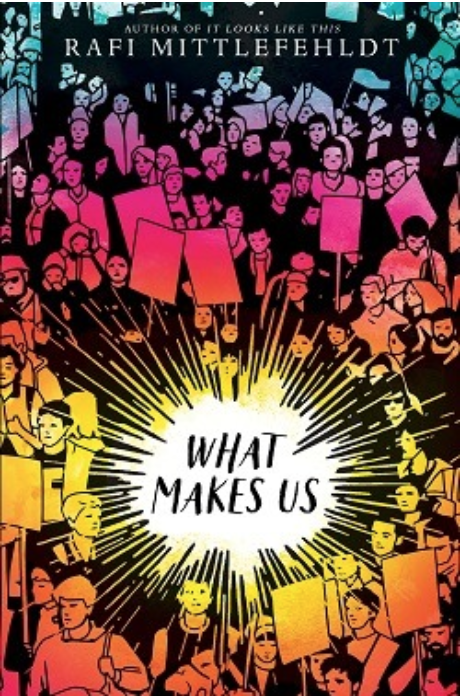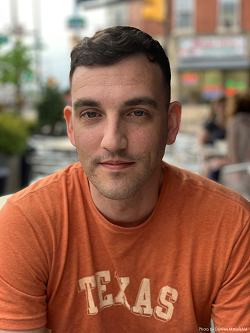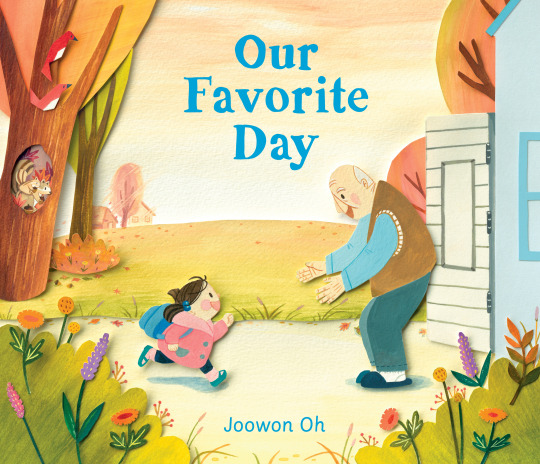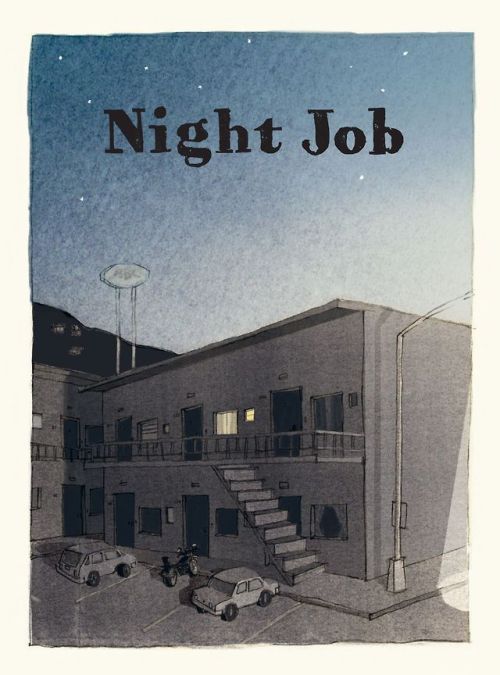#candlewick press
My favorite illustration from the very good Night Job, written by Karen Hesse and illustrated by G. Brian Karas.
[scan via Seven Impossible Things Before Breakfast]
Post link
Hypable
Hi Rafi.
It’s Monday, November 27, 2000. You just got off the phone with Dad and a weight has lifted. He told you he didn’t like how Saturday’s conversation ended because he never explicitly said that nothing’s changed; he didn’t say, “I love you.” He wanted to make sure you knew.
You did, but hearing it makes all the difference. That creeping first regret at coming out evaporates. It’s done. Everyone at college knows; now your parents know too and it’s cool. You’re done.
You’re not. It will be years before you even realize you hide this fact of you in small ways from anyone you meet. You try to act straighter than you are. You take comfort in your own natural masculinity, thinking you’re one of the lucky ones, not understanding how destructive that mindset is. You’ll avoid Pride, telling yourself it’s not your scene. You will actually think having pride in your own self is a scene.

This is the misery of internalized homophobia: Each tiny step is a battle you don’t even know you’re fighting until it’s behind you. You’re never really sure whether it’s over or another invisible battle is just gearing up.
You’ll get there, but, kiddo, it will be years. Part of that will be through your writing. Writing helps you learn so much about yourself that is there, right in front of you, but obscured behind decades of wall-building. This is how your first book will come to be.
And then, when you’ve finally, truly gotten to a point of fearlessness with one part of your identity, you’ll find you’ve been discounting another.
Remember in high school, those two kids who got in the habit of using “jewed” as a verb? They would turn to you afterwards and sheepishly apologize, every time. You would tell them you didn’t care. The worst part: you didn’t.
At an Italian restaurant, you told your friends two awful jokes. Later, the manager handed you a napkin. The family seated next to you had overheard and written you a note. They didn’t know you were Jewish too, but did that matter? You still think about their kids. They looked like they were maybe eight or ten. Do they still think about it, twenty years later?
You will.
How Jewish have you ever felt? You’ve always held that identity at arm’s length. You will continue to do that for years and years.
Then there will be an election you aren’t prepared for.
Suddenly, Jews will become more explicitly targeted than you – you, personally – have lived through. Hate crimes will increase exponentially. People carrying swastika flags will march down the street and you will think, Where did they come from?, not yet getting that they were always there.
On a Friday evening in October, a man will storm into a Pittsburgh synagogue during Shabbat services. As he shoots eleven people to death, he will shout, “All Jews must die!”
On Saturday, everyone will start adding a frame to their profile photos. Six interlocking arms forming the Star of David, with the words: “Together Against Antisemitism.” Something will finally click.
You’ll know what that frame is. You’ll know you’re supposed to feel comforted seeing so many non-Jews tell us we aren’t alone in our horror. That you’re supposed to look at those frames and see empathy, support, kinship, allyship.
You will hate those frames. They’re better than nothing, but only just. What you see instead of allyship is a way for people to provide cover for themselves. How many of the people who set their temporary profile photos engage in casual antisemitism regularly?
You will come to understand the architecture of liberal antisemitism. That it exists because too many liberals don’t view Jews as a legitimate marginalized people. They see the power dynamic within Israel, between Israelis and Palestinians, and extrapolate that to the Jewish diaspora in America.
They will say Israel should cease to exist. They will say the Star of David should be banned. They will make sly references to the power Jews hold, furtive allusions to money or loyalty or globalism. You will think a lot about how enduring anti-Jewish tropes are, even for people who pride themselves in their enlightenment.
You will call out casual antisemitism when you see it, and immediately be labeled a Netanyahu apologist. You will never again feel comfortable criticizing fellow progressives without first making clear your positions on racist Israeli policy. This will baffle you. It shouldn’t. You are an Israeli Jew, so what’s the point of nuance?
When they finally understand your beliefs are aligned with theirs, they will tell you you’re too sensitive. They, white non-Jews, will explain to you what antisemitism is. It’s Pittsburgh you should be focused on. It’s Trump. They will define thresholds that allow them to see their remarks, perversely, as a tool of social justice. They will use euphemisms – “confrontational language” and “justified criticism” – to make their antisemitism more palatable to their own consciences. You will learn what fraudulent progressivism looks like.
You will realize one day that white right-wing anti-Semites kill Jews, but only because white liberal anti-Semites give them cover to believe our lives are worth less.
You’ll write a second book. It will, to your great shame, need prodding from other people to become as Jewish as it obviously should have been. But a round of editing will take you from hating this book to loving it. It will end up meaning so much more to you than you ever expected. It will become a reflection of things you felt but couldn’t yet name.
It won’t be near enough. You’ll read the final version and be… content. It will stick to capturing right-wing antisemitism. Because that’s more violent, because it’s more urgent and orders of magnitude more deadly.
But there will be so much more you want to say. Words you left between the lines, for those who care to find them. But between the lines is a poor substitute for black and white.
You’ll get there. You’re not there yet, but you will be. There will be more books. You’ll use them both to learn more about yourself and to tell others what can be.

Rafi Mittlefehldt is a writer who has worked as a newspaper reporter, freelance theater critic, and children’s author. His debut novel was It Looks Like This. Rafi Mittlefehldt lives with his husband in Philadelphia.
By Mina Javaherbin
I grew up in prerevolutionary Iran and immigrated to the United States when I was a teen. My new book, My Grandma and Me, is an homage to a peaceful childhood, when everyday activities are bliss. When I came to America, I was running from war and revolution. It took me a long time and a considerable amount of money to follow the immigration procedures and become an American citizen. All this happened before mass immigrations, revolutions, and wars in other countries had made a noticeable dent in the American psyche. These days the internet has caused a silent revolution in everyone’s consciousness and we are more aware of our global village.
Terms such as global village,multicultural, and diversity did not trend during my childhood. However, we’ve always known about one another, and we even try to communicate—hence the United Nations. But it’s clear from the recurring disagreements and wars that sitting across a table in a large building is not enough, and a multicultural mind-set is needed to prevent things from getting lost in translation.

Immigrants have the basic foundation of becoming multicultural readily available, as we already have to deal with two cultures. But the degree of immersion varies. I can only speak of my own immigrant experience, and I’m genuinely interested in both my Iranian and American cultures. Something exquisite happens when a person opens themselves to learning about more than one belief, one lifestyle, and one language. For me, it enhanced my relationship with cultures beyond the Iranian and American.
I’m passionate about writing from my multicultural perspective, which was bolstered by my immigration but fostered from early childhood through extensive travel and multilingual education. But why should my books about different people and places be worth sharing with the lucky majority who grow up in the culture they are born into? Because technology and ease of travel has now placed us in one another’s backyards, and whether we like it or not, we have become neighbors. If we refuse to know our neighbors and instead build territorial walls, we are alienating people who most likely share similar challenges and dreams, people we could bond with and befriend. Books about people we don’t know—or are afraid of—cultivate a multicultural mind-set so that when we meet these people, we’re more comfortable with their culture.
As a multicultural author, I write to help create multicultural readers. I hope my readers wonder, What would I do or think if I lived in the world of this book? Understanding how views are formed in different settings gives us a multicultural outlook that brings about respect, sometimes to the degree of advocacy for people we disagree with. And the ability to see a multitude of viewpoints prevents a multicultural person or society from permitting the absolute rule of a singular dogma. So let’s all become multicultural and relegate wars to museums. We all deserve peaceful childhoods—and adulthoods—with our beloved grandmas.


Mina Javaherbin has written several award-winning picture books, including Soccer Star, illustrated by Renato Alarcão, and Goal!, illustrated by A. G. Ford. She lives in Southern California.
By Joowon Oh
Our Favorite Day is a book about the bond between Papa and his granddaughter.
Every morning, Papa starts his day by drinking some tea, watering his plants, and tidying up. Then he takes the bus into town to have his favorite lunch — dumplings! Papa enjoys his daily tasks, but Thursdays are his favorite, because that’s the day his granddaughter visits him. On that day, he buys some art supplies from the craft store, gets two orders of dumplings to go, and picks some flowers that he sees along the path. When his granddaughter finally arrives, they spend time together sharing dumplings, tiding up, doing arts and crafts, and flying a kite they make.
This tale of a grandfather’s love for his granddaughter was inspired by my childhood memories of my own grandfather. In the story, Papa and his granddaughter don’t live together, as I wanted their Thursdays to be particularly special, but my grandfather actually lived with my family until he passed away when I was eleven years old.

I have a lot of good memories with him, but the first thing that always comes to mind are the times we shared steamed dumplings in our dining room after school. After my grandmother passed away, my grandfather often had lunch alone at home or in the city, since my parents were at work and my siblings and I were at school. On the days he had dumplings for lunch in the city, he would bring some home for me and my siblings. When I got home from school, he would call me to our dining room and give me the dumplings to eat, sometimes wrapped in a napkin in his coat pocket. I think he did this out of habit: during the Korean War, food was very precious, and he may have saved leftovers like that then. I sometimes bit into a dumpling where a piece of napkin wasn’t peeled off properly, but I was never annoyed, because I knew that these dumplings were his love for us.
We would sit together, spending most of the late afternoons eating dumplings and talking about what I learned at school, how my exam went, what I did with my friends, and what my homework was for the next day. I loved those moments with him, not only because the dumplings were sweet, but also because I felt his love for me in the way he would look at me so endearingly while smiling tenderly. This may seem like a simple and insignificant detail in one’s childhood, but for me, it is a cherished moment that inspired me to write my very first children’s book about the special relationship between a grandparent and grandchild — and dumplings.
I started off by building Papa’s character, trying to visualize all the memories I had of my grandfather and jotting them down: wrinkles and age spots on his hands and face, gray hair, coat and knitted vest, cane, hat, shoes, slippers, pajamas, bedroom, plants, plant pots, hunched back, the way he walked, and so on. Then I set up Papa’s day, imagining what his routine would be by asking myself, What does he spend his time doing at home all alone? How does he get to the city? Where does he sit at the dumpling restaurant? Before his granddaughter comes home, what does he do to prepare for her?
In my initial story line, I wanted to show Papa’s loneliness while performing his daily routines, like when he is at home or eating alone at the restaurant, to contrast with his time with his granddaughter. However, my editor, Kate, suggested that it would be nice if I could create a community of people who care for and are interested in Papa and his life despite his living so quietly. We decided to add some dialogue with the waitress of the dumpling house and the craft shop owner to enhance the story, but also to ensure that Papa doesn’t seem like a lonely old man. I thought this was a great idea so that kids can see that their grandparents are people who can still enjoy their lives with their community and family.
The granddaughter is a sweet and creative little girl. She loves dumplings, polka dots, flowers, and drawing. She wants to make a butterfly kite instead of a traditional kite and decorates the string with the flowers that Papa picked for her. She is also a caring girl who likes to help Papa wash the dishes, thread a needle, and button his coat. Without her, the story cannot be complete. She is the reason that Papa looks forward to Thursdays.

In terms of the art-making process: After I received the revised text from my editor, my designer, Lauren, sent me an empty paging dummy with only the revised text and her and the editor’s notes about the illustrations on the bottom. Since the story had changed from my initial draft, I had to ignore most of the sketches in my old dummy and start all over again. I had to make thirty-two new sketches. At first, I thought this would be challenging, but I ended up enjoying the process.
First, I worked on the overall pacing of the story and the page layout. Since I wanted Papa’s typical day to move at a more leisurely pace in the beginning of the story, I drew only a single image or two on a page. Then when it was Thursday, I drew more panels per page to show how the pace of the story quickens as Papa has a lot to do in preparation for his granddaughter. For the scene where the granddaughter arrives, I drew a full spread because I wanted readers to pause to enjoy this big moment, the moment that the whole story has been building up to.
Then I tried drawing the scenes in different perspectives. They varied depending on what emotions and moments I wanted to convey through each scene. It was almost like filming a movie, with all the different angles. I kept asking myself, What perspective would be best to make readers feel as if they are watching Papa’s routines as observers? Should it be a high angle from above or a low angle to make Papa look small and weak compared to people passing by in the city? Should I zoom in on his hand and shoes instead of showing his whole body during the quiet moment when he bends down to pick flowers? I produced a couple of different sketches for each scene before deciding on a final composition.
While I was concentrating on depicting what was said in the text, I also had fun adding what was not said to make the illustrations more rich and to engage readers to open their imaginations. For example, in Papa’s bedroom, there is a photograph of Grandma wearing a polka-dotted dress and another of her holding a flower, two things that her granddaughter also likes. There is no explanation of what happened to Grandma, and I hope kids reflect on why the illustrator included photos of her in Papa’s bedroom, and also how he may feel when looking at these photographs.
To create the images, I used watercolor, white gouache, and colored paper. First, I sketched a scene on a lightweight paper and put watercolor paper on the top of the sketch. Then I traced some images out of the scene using a light box and painted them with watercolor mixed with white gouache. I cut out each image and put rolled tape on the back of the cutouts, then put it all together on a painted background. The reason I used rolled tape instead of glue was to create shadows underneath the cutouts and to make my artwork look more three-dimensional and tangible. It was a time-consuming process, but without it, I wouldn’t have been able to create the unique look.
Childhood doesn’t last forever, and the moments that kids can share with their grandparents are limited. Last week, I visited North Carolina to see my sister’s family, and my parents also came from Korea. My niece is almost two years old, and my nephew is five months old. I’m sure you can imagine how adoringly my parents look at their grandchildren. As I was watching my father play with his granddaughter, my giggling niece reminded me of myself and my father’s playful expression reminded me of my grandfather. I knew a grandchild could be the only one to bring out these emotions in my father. We all have childhood memories that will stick with us for the rest of our lives. They create who we are, shape our lives, help us find our purpose, and teach values. Even though my grandfather is no longer here and the dumpling restaurant no longer exists, the love and the warm memories that I was able to create with him have lasted. And as these memories have inspired me to write this book, I hope kids today will have great times with their grandparents, cherish every moment, and give the warmth they feel back to the world in their own ways.


Joowon Oh is originally from South Korea. She earned a BFA in illustration and an MFA in illustration as visual essay from the School of Visual Arts in New York. She works primarily in watercolor with a little bit of gouache and paper collage. Our Favorite Day is her picture book debut. She lives in New York City.


